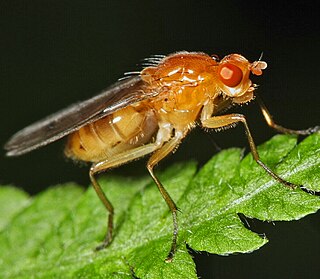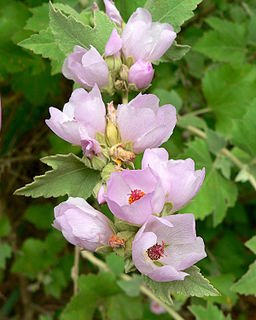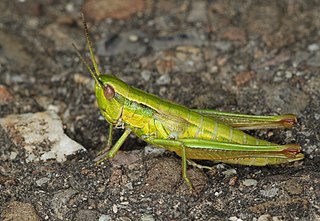
The New World warblers or wood-warblers are a group of small, often colorful, passerine birds that make up the family Parulidae and are restricted to the New World. They are not closely related to Old World warblers or Australian warblers. Most are arboreal, but some, like the ovenbird and the two waterthrushes, are primarily terrestrial. Most members of this family are insectivores.

Tarsiiformes are a group of primates that once ranged across Europe, northern Africa, Asia, and North America, but whose extant species are all found in the islands of Southeast Asia. Tarsiers are the only living members of the infraorder, and also include the extinct Tarsius eocaenus from the Eocene and Tarsius thailandicus from the Miocene. Two extinct genera, Xanthorhysis and Afrotarsius, are considered to be close relatives of the living tarsiers and are generally classified within Tarsiiformes, with the former grouped within family Tarsiidae and the latter listed as incertae sedis (undefined). Omomyids are generally considered to be extinct relatives, or even ancestors, of the living tarsiers and are often classified within Tarsiiformes. Other fossil primates, which include Microchoeridae, Carpolestidae, and Eosimiidae, have been included in this classification, although the fossil evidence is debated. Eosimiidae has also been classified under the infraorder Simiiformes. Likewise, Carpolestidae is often classified within the order Plesiadapiformes, a very close, extinct relative of primates. These conflicting classifications lie at the heart of the debate over early primate evolution. Even the placement of Tarsiiformes within suborder Haplorhini is still debated.

Harold Calvin Marston Morse was an American mathematician best known for his work on the calculus of variations in the large, a subject where he introduced the technique of differential topology now known as Morse theory. The Morse–Palais lemma, one of the key results in Morse theory, is named after him, as is the Thue–Morse sequence, an infinite binary sequence with many applications. In 1933 he was awarded the Bôcher Memorial Prize for his work in mathematical analysis.
Grayling or Greyling may refer to:

Conocephalus is a genus of bush-crickets, known as coneheads. It was described by Carl Peter Thunberg in 1815.

The Dryomyzidae are a small family of flies ranging from 4–18 mm long, with prominent bristles, and yellow to brown or rust-yellow coloring. The wings are very large. The subcosta is complete and well separated from vein 1. Larvae feed on decaying organic matter - carrion, dung, and fungi. The prelambrum protrudes from the oral cavity. Vibrissae are absent and the postvertical bristles are divergent.

Banksia ser. Crocinae is a taxonomic series in the genus Banksia. The series was first published by Alex George in 1981, but discarded by Kevin Thiele and Pauline Ladiges in 1996, and finally reinstated by George in 1999. Recent cladistic analyses suggest that it is monophyletic or nearly so.

Enallagma is a genus of damselflies in the family Coenagrionidae commonly known as bluets. The genus consists of the following species:

Eustigmatophytes are a small group of eukaryotic algae that includes marine, freshwater and soil-living species.

Vertigo is a genus of minute, air-breathing land snails, terrestrial pulmonate gastropod molluscs or micromollusks in the family Vertiginidae, the whorl snails.
Aglaothorax is a genus of ovate shieldbacks in the family Tettigoniidae. There are about six described species in Aglaothorax.

Ophiogomphus, commonly known as snaketails, is a genus of dragonflies in the family Gomphidae. Most of the species in the genus Ophiogomphus have beautifully marked green club-shaped abdomens, which are more noticeable in the males.

Valloniidae is a taxonomic family of small and minute, air-breathing land snails, terrestrial pulmonate gastropod mollusks in the superfamily Pupilloidea.

Malacothamnus (bushmallow) is a genus of shrubs and subshrubs found throughout much of mainland California and on three of the Channel Islands. Outside of California, Malacothamnus is known from the northern half of Baja California, from a disjunct location in central Arizona, and possibly from a historic location that may have been in southern Arizona or adjacent Mexico. Plants of this genus are most commonly found in early-successional, post-burn plant communities. Malacothamnus are currently thought to be most closely related to the Iliamnas of the US interior and the Phymosias of Mexico, Central America, and the Caribbean.

Perpolita is a genus of air-breathing land snails, terrestrial pulmonate gastropod mollusks in the family Gastrodontidae.

Calbovista is a fungal genus containing the single species Calbovista subsculpta, commonly known as the sculptured puffball, sculptured giant puffball, and warted giant puffball. It is a common puffball of the Rocky Mountains and Pacific Coast ranges of western North America. The puffball is more or less round with a diameter of up to 15 cm (6 in), white becoming brownish in age, and covered with shallow pyramid-shaped plates or scales. It fruits singly or in groups along roads and in open woods at high elevations, from summer to autumn.
Planogyra is a genus of small air-breathing land snails, terrestrial pulmonate gastropod mollusks in the family Valloniidae.

Gomphocerinae, sometimes called "slant-faced grasshoppers", are a subfamily of grasshoppers found on every continent but Antarctica and Australia.
Pseudopomala is a genus of slant-faced grasshoppers in the family Acrididae. There is one described species in Pseudopomala, P. brachyptera.
Bownomomys was an early marmoset-like primate that lived in North America during the Early Eocene epoch, about 56-50 million years ago.














